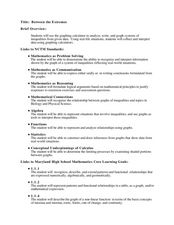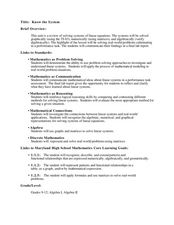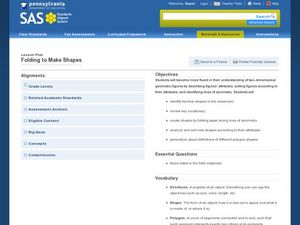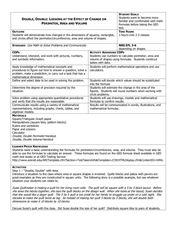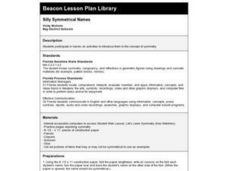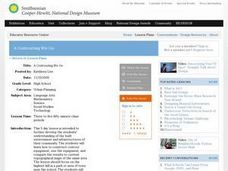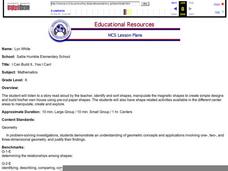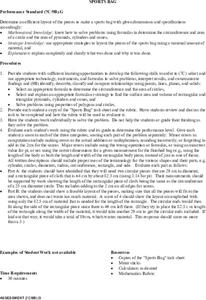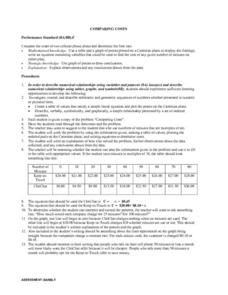Curated OER
Between The Extremes
Students analyze graphs for specific properties. In this algebra lesson, students solve equations and graph using the TI calculator. They find the different changes that occur in each graph,including maximum and minimum.
Curated OER
Investing
Students collect data on investments and draw conclusions. In this algebra lesson, students analyze exponential graphs as they relate to money. They discuss the cause of an account balance being high or low.
Curated OER
Know the System
Pupils identify the different systems of equations. In this algebra lesson, students solve systems of equations using graphing, elimination and substitution. They use the Ti to graph their systems.
Curated OER
Folding to Make Shapes
Second graders identify different polygons and their attributes. In this geometry lesson, 2nd graders get to know polygons by studying the vocabulary and finding polygons in their classroom. They create these shapes and then find their...
Curated OER
Double, Double: Looking at the Effect of Change on Perimeter, Area and Volume
Learners explore perimeter, volume, and area. In this math lesson plan, students explore how changes in dimensions of geometric shapes affect the perimeter, area and volume of the various shapes. Learners investigate the results when the...
Curated OER
Scale Me Down
Students create scale drawings, and ultimately scale models, of real-world objects in this Math activity about ratios, proportion, scaling factors, and cross products. The activity includes ideas for cross-curricular extensions and is...
Curated OER
Equilateral Triangles
Students examine the attribute of equilateral triangles. In this equilateral triangle lesson plan, students examine a number of paper triangles to determine how they are classified. They determine how triangles are depicted in Navajo rugs.
Curated OER
Terrific Tessellations
Students explore tessellations that are found in nature and everyday objects. They observe the works of M.C. Escher. Students create their own tessellations using pencil and paper.
Curated OER
Silly Symmetrical Names
Fourth graders participate in hands-on activities to introduce them to the concept of symmetry. They make a silly symmetrical picture out of their names after gluing them onto a larger sheet of construction paper. This is a really...
Curated OER
Double Exposed Photographs
Students create double-exposed photographs, poetry, and multimedia presentations. In this artwork lesson plan, students explore cameras, poems, and other art forms to understand line, light, and other attributes that contribute to artwork.
Curated OER
Deductive Reasoning
Tenth graders investigate deductive reasoning. In this geometry instructional activity, 10th graders compare and contrast inductive ns deductive reasoning. Students use deductive reasoning to investigate algebraic proof and...
Curated OER
Clay Tile: Art Deco Style
Students analyze and classify sets of pictures using a mathematical classification system and create original works of Art Deco tiles using this new knowledge and four types of symmetry.
Curated OER
Symmetry, Similar & Congruent Shapes
Fifth graders identify lines of symmetry., similar and congruent shapes. They use construction paper to create their own symmetrical shapes. Students create stained glass frames containing symmetrical, congruent and similar shapes.
Curated OER
Tiling the Classroom
Learners see how to identify regular polygons, how to slide, turn and flip polygons, and why certain polygons tessellate better than others. Groups create a one foot square design to be used to tile the classroom. Great lesson!
Curated OER
A Contouring We Go
Students examine the built environment and infrastructures of their community by constructing contour equipment, using the equipment, and comparing their results to current topographical maps of the same area
Curated OER
I Can Build It.....Yes I Can!
Kindergartners listen to a story read by their teacher, then use magnetic shape pieces to construct simple designes. They "build" their own house using pre-cut paper shapes. This age-appropriate lesson would be an excellent choice for...
EngageNY
Graphing Cubic, Square Root, and Cube Root Functions
Is there a relationship between powers and roots? Here is a instructional activity that asks individuals to examine the graphical relationship. Pupils create a table of values and then graph a square root and quadratic equation. They...
Curated OER
Cylinders and Scale
Students review what a cylinder is and how a cylinder is measured. They build a variety of cylinders with different heights and radii. They compare the surface area and volume of each cylinder and discuss anything that surprises them...
Curated OER
Sports Bag
Students determine an efficient layout of the pattern pieces needed to make a sports bag with given dimensions and specifications. Given a word problem, data set and a diagram, students evaluate the information they have available and...
Curated OER
Design-a-Lesson-Packaging a Product
Middle schoolers in a teacher education class address consumer related issues involving packaging. Using volume, surface area and graphs, they create a package for a given volume of a product. They design modifications for this lesson...
Curated OER
Symmetry and Tessellations
Sixth graders investigate tessellations and their origins. Students trace triangles to form a tessellation. They measure the angle of equilateral triangles. Students locate the line of symmetry, they create geometric squares,...
Curated OER
Comparing Costs
Students compare the costs of two cellular phone plans and determine the best rate. They use a table and a graph of points plotted on a Cartesian plane to display their findings. Students write an equation containing variables that could...
Curated OER
Irregular Fractals
Students explore the concept of irregular fractals. In this irregular fractals lesson, students discuss how to find fractal dimensions through teacher led discussion. Students calculate fractal dimensions of various fractals.
Curated OER
Let's Make Lemonade Lesson 3: What's the Big Idea?
Students examine and decide on a service-learning project to perform. They design and execute posters that advertise the project using geometric shapes.
